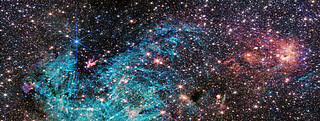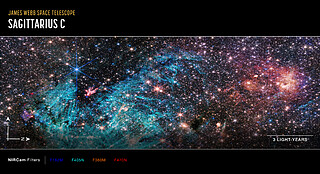weic2328 — Photo Release
Webb reveals new features in heart of the Milky Way
20 November 2023
The latest image from the NASA/ESA/CSA James Webb Space Telescope shows a portion of the dense centre of our galaxy in unprecedented detail, including never-before-seen features astronomers have yet to explain. The star-forming region, named Sagittarius C (Sgr C), is about 300 light-years from the Milky Way’s central supermassive black hole, Sagittarius A*.
Amid the estimated 500,000 stars in the image is a cluster of protostars – stars that are still forming and gaining mass – producing outflows that glow like a bonfire in the midst of an infrared-dark cloud. At the heart of this young cluster is a previously known, massive protostar over 30 times the mass of our Sun. The cloud the protostars are emerging from is so dense that the light from stars behind it cannot reach Webb, making it appear less crowded when in fact it is one of the most densely packed areas of the image. Smaller infrared-dark clouds dot the image, looking like holes in the starfield. That’s where future stars are forming.
Webb’s NIRCam (Near-Infrared Camera) instrument also captured large-scale emission from ionised hydrogen surrounding the lower side of the dark cloud, shown cyan-coloured in the image. Typically, this is the result of energetic photons being emitted by young massive stars, but the vast extent of the region shown by Webb is something of a surprise that bears further investigation. Another feature of the region that scientists plans to examine further is the needle-like structures in the ionised hydrogen, which appear oriented chaotically in many directions.
Around 25,000 light-years from Earth, the galactic centre is close enough to study individual stars with the Webb telescope, allowing astronomers to gather unprecedented information on how stars form, and how this process may depend on the cosmic environment, especially compared to other regions of the galaxy. For example, are more massive stars formed in the centre of the Milky Way, as opposed to the edges of its spiral arms?
More information
Webb is the largest, most powerful telescope ever launched into space. Under an international collaboration agreement, ESA provided the telescope’s launch service, using the Ariane 5 launch vehicle. Working with partners, ESA was responsible for the development and qualification of Ariane 5 adaptations for the Webb mission and for the procurement of the launch service by Arianespace. ESA also provided the workhorse spectrograph NIRSpec and 50% of the mid-infrared instrument MIRI, which was designed and built by a consortium of nationally funded European Institutes (The MIRI European Consortium) in partnership with JPL and the University of Arizona.
Webb is an international partnership between NASA, ESA and the Canadian Space Agency (CSA).
Image Credit: NASA, ESA, CSA, STScI, S. Crowe (UVA)
Links
- ESA Webb Seeing Farther Interactive Brochure
- Release on STScI website
- Release on ESA website
- Release on NASA website
Contacts
Bethany Downer
ESA/Webb Chief Science Communications Officer
Email: [email protected]
Ninja Menning
ESA Newsroom and Media Relations Office
Email: [email protected]
About the Release
| Release No.: | weic2328 | |
|---|---|---|





